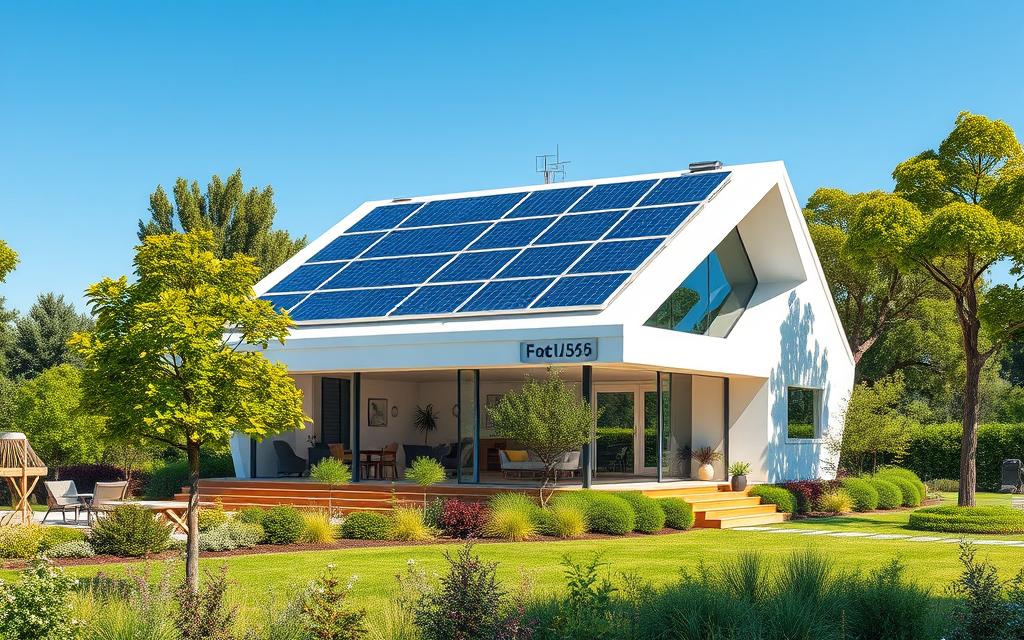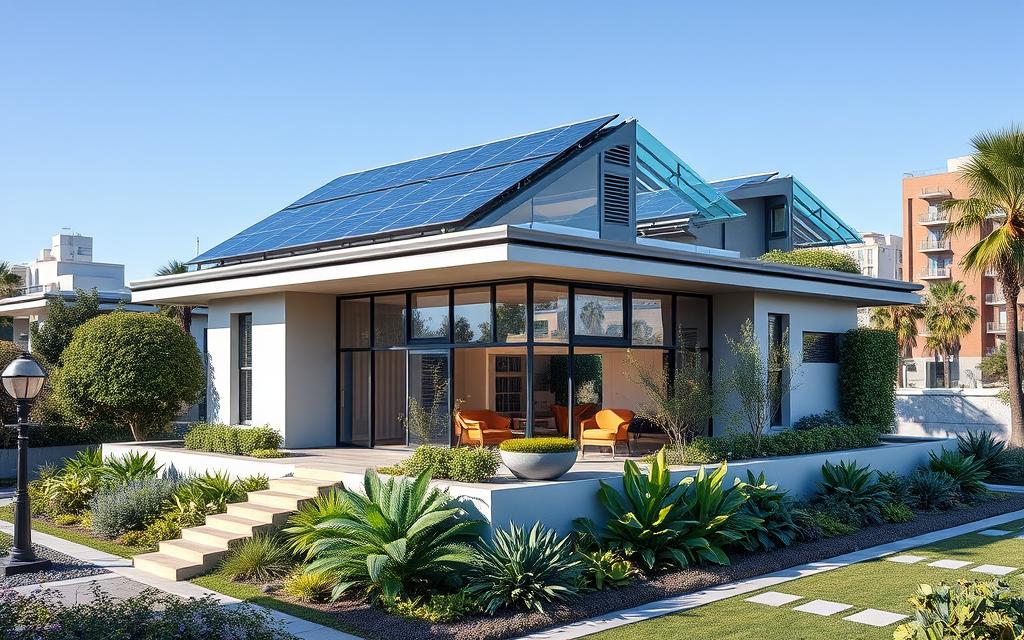Understanding E-House: A New Technology
E-house technology is changing how we build electrical systems. It uses prefabricated enclosures with modular electrical systems. This makes it flexible and protects important equipment well.
It’s growing fast, with a 6.83% increase in use. This shows we need better, more custom electrical systems.
In today’s world, being able to control power from a distance is key. E-houses are a smart choice because they’re cheaper and safer than old ways. They also make projects start and finish faster.
What is E-House New Technology
E-houses change how we think about electrical solutions, bringing a new way to build. To understand e-houses, we see them as prefabricated electrical units ready to be set up quickly. They have key parts like switchgear and automation cabinets, making them perfect for many uses.
Definition and Overview
An e-house is a flexible structure that makes electrical systems work well in places where speed and reliability matter. It’s built with advanced engineering, ensuring it’s safe and works well. It becomes a central hub with automated systems like Programmable Logic Controllers (PLC), controlling all the electrical parts.
Historical Context
The need for fast, safe, and efficient electrical solutions has driven the e-house’s history. Industries like energy and mining have pushed for portable and adaptable systems. Companies like ABB have made big steps with prefabricated substations.
This shift from old methods to e-houses shows how engineering has evolved. It allows for quicker projects and less hassle on-site.
The Basics of E-House
E-Houses are a new way to handle electrical distribution. They are compact and flexible. Knowing about e-house components and custom designs shows how they meet different needs.
Components and Structure
An e-house has key parts for better performance and use. These include:
- Structural frames that are strong and supportive.
- Electrical wiring made for specific uses.
- Customised equipment layouts for various needs.
- Materials that are reliable and save space.
Companies like ABB and Siemens use prefabrication. ABB eHouses hold switchgear and critical power gear. This method cuts down installation time and makes projects more predictable.
The modular design lets for creative solutions. This meets project needs while keeping things reliable.
Customisation Options
Customisation is key for e-house solutions. Each e-house can be made to fit specific needs. This makes them useful for any industry. Some popular choices are:
- Modular setups for projects across multiple buildings.
- Custom designs for unique site conditions.
- Advanced technologies for better performance.
E-houses can be made for both temporary and permanent use. This helps industries deal with tough environments. They also save on costs and time by combining systems in one place. This flexibility is crucial in today’s fast-changing market.
Engineering and Design of E-Houses
The engineering and design of an e-house need careful planning. As e-house engineering grows, key factors make the design strong and effective. These include important design choices and the structure’s strength, both crucial for performance and safety.
Design Considerations
When designing an e-house, several things are important. Efficiency and flexibility are top priorities. Good e-house design makes them modular, fitting various industry needs.
- Equipment spacing and setup must match operational needs.
- Wiring layout is crucial for efficiency and safety.
- Adding safety features, like electrical arc flash protection and fireproofing, is essential.
- Working with local authorities ensures the design meets building codes, avoiding costly mistakes.
Designing for flexibility can greatly reduce installation and startup times. Quad Plus offers options like sub-floor or raised tray designs to save space and improve function. With ISO standard sizes and custom designs, adaptability is key in modern e-house solutions.
Structural Integrity
The strength of e-houses is critical. Designs must account for wind, seismic activity, and site conditions. This ensures the structures can handle harsh weather and site challenges, maintaining performance.
Quality control checks are common in the e-house industry. These checks confirm e-houses work well in real conditions, giving businesses confidence. Successful e-house projects boost efficiency and productivity, offering economic benefits over traditional substations.
In conclusion, focusing on e-house engineering, design, and structure leads to successful projects. This allows industries to use this innovative solution with confidence.
Benefits of Implementing E-House Technology
E-house technology brings many benefits, especially in saving costs and improving operations. Its design and modular build offer a new way to handle electrical needs in different fields. This part looks at how these benefits work in real life.
Cost Efficiency
Using e-house technology saves a lot of money during a project. It makes electrical solutions cheaper because it cuts down on construction costs. Swartz Engineering can offer better prices for making and installing e-houses because they work in a controlled space.
Labour costs are a big part of this. Moving work from the site to a workshop lowers the risk of delays. This also helps with planning and getting things done faster.
Also, the way e-houses are built makes projects run smoother. By ordering parts early and working on e-houses while other parts of the project are being done, projects finish quicker. This is great for industries where time is very important.
Operational Excellence
E-house technology also improves how things work, not just the cost. Because they are built in a standard way, they meet strict safety and quality rules in 28 countries. This means they are reliable and strong, which is key for keeping things running smoothly.
Also, e-houses make work flow better and projects more predictable. Swartz Engineering makes e-houses for many industries, like green energy and data centres. They combine local making with a global design, making sure each e-house fits exactly what’s needed. This leads to top-notch performance and function.

Applications of E-Houses Across Industries
E-houses are versatile and used in many fields, especially in energy and mining. They are designed to be efficient and save space. This helps industries work better, stay safe, and keep costs down.
Energy Sector
E-houses are crucial in renewable energy and power plants. They keep important electrical gear safe and efficient. The benefits of using them include:
- Quick deployment: E-houses can be set up fast, cutting down on delays.
- Cost reduction: Building them off-site saves money and avoids unexpected costs.
- Eco-friendly features: They often use energy wisely and can add to renewable energy systems.
- Space efficiency: E-houses take up less space, perfect for tight spots.
Mining and Processing
In mining, e-houses are key for electrical needs in tough places. They act as control rooms and power centers. The benefits for mining are:
- Modular design: E-houses can be changed and grown to fit different needs.
- Safety features: They have special safety features like explosion-proof designs.
- Integrated control systems: They help monitor and manage power in real-time.
- Rapid deployment: Their prefabricated nature means they can be set up quickly.
E-houses are adaptable to many industrial needs. They are vital in energy and mining. As more areas see their value, e-houses will play an even bigger role in making operations effective and green.
Integration and Installation Process
The integration and installation of e-houses is key. It makes sure these advanced structures work well in their places. Good planning and setup help operations run smoothly and safely.
Transportation to Final Destination
Getting e-houses to their final spot needs careful planning. Companies like Kontrolmatik in Ankara, Türkiye, are experts at this. They deliver their prefabricated e-houses safely all over the world.
Because of less design and engineering, setting up e-houses is faster. This saves time and money compared to traditional methods.
Site Preparation
Preparing the site for e-houses is crucial. It involves checking things like grounding and following local rules. This makes sure the site is safe and ready for use.
E-houses are easy to install because they come pre-set up. This means less time on site and fewer risks. They also have special safety features for extreme temperatures.
| Feature | Benefits |
|---|---|
| Reduced Engineering Phase | Shorter delivery times and minimized costs |
| Pre-Commissioned Systems | Decreased commissioning time and site installation |
| Integrated Equipment | Lower cable costs and improved installation efficiency |
| Built-In Safety Measures | Enhanced protection for equipment and personnel |
| Compliance with Standards | Operational reliability in diverse environmental conditions |
Maintenance and Repair for Long-Term Use
To keep e-houses working well for a long time, regular maintenance and following repair guidelines are key. This helps keep them safe and functional. Regular checks are important to spot problems early, helping the e-house last longer.
Regular Inspections
Inspections should look at important things like:
- Structural integrity
- Electrical components
- Protective measures against environmental degradation
These inspections help fix issues fast. This ensures the e-house works well and is safe.
Common Issues and Solutions
Even with good care, problems can still happen, like:
- Water intrusion
- Wire degradation
- Equipment malfunctions
It’s important to solve these problems quickly. For example, water damage can weaken the e-house’s structure. Wires that wear out can be dangerous. Quick fixes can save time and money in the long run.
For more tips on e-house upkeep, check out the e-house repair guidelines from experts.
Safety and Compliance Considerations
In the world of e-house technology, safety and following rules are key. Building e-houses that follow strict standards helps avoid costly delays and keeps everyone safe. It’s crucial for companies to work with engineers who know all the local and national rules.
Meeting Industry Standards
Following e-house safety rules means knowing the right codes and standards. This includes GB, ISO, and IEC. Using modular prefabricated solutions helps lower risks. It also means less work for clients during planning and management, while keeping safety in mind from the start.
Regulatory Considerations
Staying in line with e-house rules is important at every stage. Suppliers like ABB offer custom solutions that meet these high standards. They help manage projects on time and within budget. As the industry moves towards better safety and green practices, following rules and ethics is vital for all involved in e-house systems. For more on e-house trends, check out this detailed market analysis.
FAQ
What are E-Houses?
E-Houses, or electrical homes, are prefabricated units for sensitive equipment. They offer a modular system that’s efficient and flexible. They’re designed for many uses in today’s industrial world.
How do E-Houses benefit the construction and engineering industry?
E-Houses make operations better by cutting costs and reducing setup times. They also make projects more predictable and safer. Their design allows for quick setup and meets different site needs.
What are the main components of an E-House?
An E-House has structural frames, electrical wiring, and custom equipment layouts. These are tailored for various needs and standards. This makes E-Houses great for many uses.
What is the importance of engineering design in E-Houses?
Engineering design is key for E-Houses. It covers safety, equipment spacing, and structure. This ensures they can handle tough environments and work well once set up.
Where are E-Houses commonly used?
E-Houses are mainly used in the energy sector, like renewable projects and power plants. They’re also used in mining and processing where they need to be tough.
What factors contribute to the cost efficiency of E-Houses?
E-Houses are cost-effective because they’re quick to install and need little civil work. This saves money and boosts operational benefits.
How is the installation of E-Houses managed?
Installation planning is detailed to ensure units arrive safely. Site prep includes checks for grounding and local rules. This is key to a smooth setup.
What maintenance is required for E-Houses?
Regular checks on structure and electrical parts are crucial. Fixing problems like water damage and equipment issues quickly helps avoid big costs. It also keeps the E-House running long-term.
Why is safety compliance significant for E-Houses?
Safety and following rules are very important for E-Houses. They must meet industry standards to avoid fines. Working with engineers who know local and national codes is essential to stay safe and legal.









